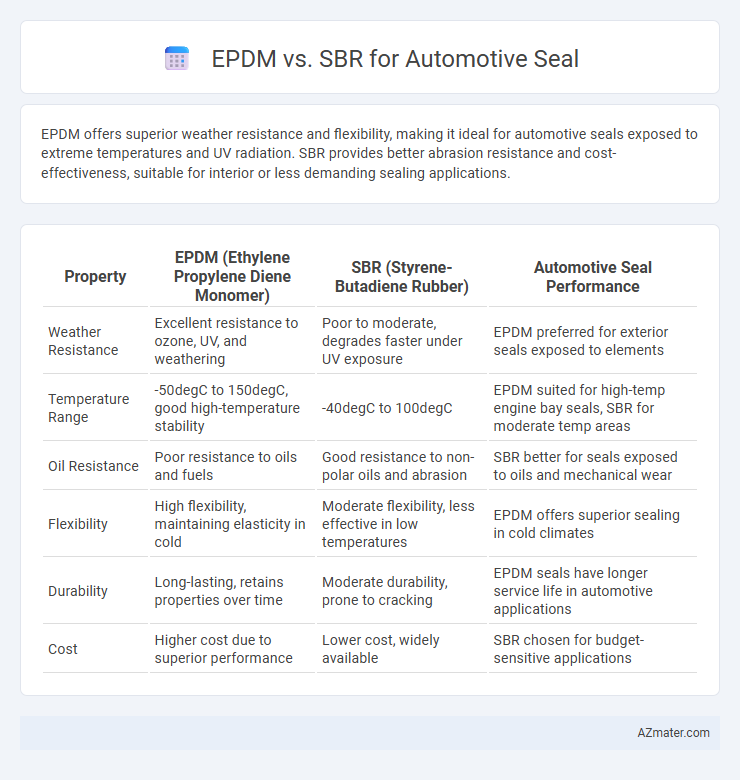EPDM offers superior weather resistance and flexibility, making it ideal for automotive seals exposed to extreme temperatures and UV radiation. SBR provides better abrasion resistance and cost-effectiveness, suitable for interior or less demanding sealing applications.
Table of Comparison
| Property | EPDM (Ethylene Propylene Diene Monomer) | SBR (Styrene-Butadiene Rubber) | Automotive Seal Performance |
|---|---|---|---|
| Weather Resistance | Excellent resistance to ozone, UV, and weathering | Poor to moderate, degrades faster under UV exposure | EPDM preferred for exterior seals exposed to elements |
| Temperature Range | -50degC to 150degC, good high-temperature stability | -40degC to 100degC | EPDM suited for high-temp engine bay seals, SBR for moderate temp areas |
| Oil Resistance | Poor resistance to oils and fuels | Good resistance to non-polar oils and abrasion | SBR better for seals exposed to oils and mechanical wear |
| Flexibility | High flexibility, maintaining elasticity in cold | Moderate flexibility, less effective in low temperatures | EPDM offers superior sealing in cold climates |
| Durability | Long-lasting, retains properties over time | Moderate durability, prone to cracking | EPDM seals have longer service life in automotive applications |
| Cost | Higher cost due to superior performance | Lower cost, widely available | SBR chosen for budget-sensitive applications |
Introduction to EPDM and SBR in Automotive Seals
EPDM (Ethylene Propylene Diene Monomer) and SBR (Styrene-Butadiene Rubber) are two commonly used elastomers in automotive seals due to their distinct chemical properties. EPDM exhibits excellent resistance to heat, ozone, and weathering, making it ideal for exterior automotive seals exposed to harsh environmental conditions. SBR offers good abrasion resistance and mechanical strength, often utilized in interior seals where flexibility and durability under moderate environmental stress are required.
Chemical Composition and Structure Comparison
EPDM (ethylene propylene diene monomer) features a saturated hydrocarbon backbone with diene monomers, providing exceptional resistance to ozone, weathering, and polar chemicals. SBR (styrene-butadiene rubber) consists of styrene and butadiene units in a copolymer structure, offering moderate chemical resistance but higher susceptibility to heat and ozone degradation. The saturated structure of EPDM results in superior durability for automotive seals exposed to harsh environmental and chemical conditions compared to the unsaturated, more reactive double bonds in SBR.
Key Performance Properties of EPDM
EPDM (Ethylene Propylene Diene Monomer) exhibits superior resistance to heat, ozone, and weathering compared to SBR (Styrene-Butadiene Rubber), making it ideal for automotive seals exposed to harsh environmental conditions. Key performance properties of EPDM include excellent flexibility over a wide temperature range (-40degC to 150degC), strong resistance to oxidation, and outstanding compatibility with automotive fluids like brake fluid and coolant. These attributes ensure long-lasting sealing performance and durability in critical automotive applications.
Key Performance Properties of SBR
Styrene-Butadiene Rubber (SBR) offers excellent abrasion resistance and good tensile strength, making it suitable for automotive seals exposed to mechanical wear and stress. SBR's cost-effectiveness and good aging properties under normal atmospheric conditions provide a balance between performance and economy. However, SBR has limited resistance to heat, ozone, and oil compared to EPDM, requiring consideration of the specific environmental demands in automotive sealing applications.
Resistance to Heat, Weather, and Ozone
EPDM (Ethylene Propylene Diene Monomer) exhibits superior resistance to heat, weather, and ozone compared to SBR (Styrene-Butadiene Rubber), making it the preferred choice for automotive seals exposed to harsh environmental conditions. EPDM maintains its elasticity and durability under high temperatures up to 150degC and withstands prolonged UV and ozone exposure without cracking or degrading. SBR, while cost-effective, is prone to faster deterioration when subjected to heat, ozone, and weathering, limiting its effectiveness in automotive sealing applications requiring long-term reliability.
Flexibility and Elasticity Differences
EPDM (ethylene propylene diene monomer) offers superior flexibility and elasticity compared to SBR (styrene-butadiene rubber), making it ideal for automotive seals exposed to varying temperatures and weather conditions. EPDM maintains its elasticity at low temperatures, preventing cracks and seal failures, while SBR tends to become brittle and lose flexibility over time. This enhanced performance under thermal stress positions EPDM as the preferred material for durable, long-lasting automotive sealing applications.
Cost-Effectiveness and Manufacturing Considerations
EPDM rubber offers superior resistance to heat, ozone, and weathering, making it ideal for automotive seals subjected to harsh environments, though it generally has a higher material cost than SBR. SBR provides a cost-effective alternative with good abrasion resistance and lower initial expense, but it lacks the long-term durability required for seals exposed to automotive fluids and extreme temperatures. Manufacturing processes for EPDM often require specialized mixing and curing techniques, slightly increasing production complexity, whereas SBR benefits from simpler, more established manufacturing methods that reduce processing time and overall costs.
Long-Term Durability and Maintenance
EPDM rubber offers superior long-term durability for automotive seals due to its excellent resistance to heat, ozone, and weathering, ensuring prolonged performance in harsh engine bay environments. SBR, while cost-effective and offering good abrasion resistance, tends to degrade faster under UV exposure and extreme temperatures, leading to more frequent maintenance and replacement. Choosing EPDM minimizes maintenance costs and extends seal lifespan, making it ideal for critical automotive sealing applications requiring long-term reliability.
Typical Automotive Applications for EPDM vs SBR
EPDM is widely used for automotive seals in weatherstripping, window seals, and coolant system gaskets due to its exceptional resistance to ozone, UV rays, and heat. SBR, while less resistant to environmental factors, is commonly applied in interior parts, door seals, and secondary sealing tasks where abrasion resistance and flexibility are prioritized. The choice between EPDM and SBR typically depends on specific application requirements such as exposure to elements, temperature range, and mechanical stress.
Final Recommendation: Choosing the Ideal Seal Material
EPDM offers superior resistance to heat, ozone, and weathering, making it ideal for automotive seals exposed to harsh environments. SBR provides excellent abrasion resistance and is cost-effective but has limited resistance to ozone and heat compared to EPDM. For optimal durability and performance in automotive sealing applications, EPDM is the preferred material choice.

Infographic: EPDM vs SBR for Automotive seal
 azmater.com
azmater.com